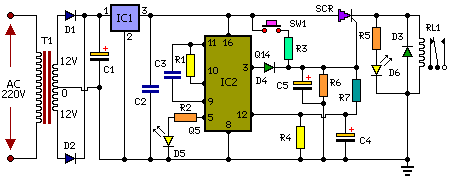Home » Circuits
Safety Guard
Simple unit, Protects home appliances from voltage spikesProtect your home appliances from voltage spikes with this simple time delay circuit. Whenever power to the appliances is switched on or resumes after mains failure, the oscillator starts oscillating and D5 blinks. This continues for three minutes. After that, Q14 output of IC CD4060 goes high to trigger the gate of the SCR through D4. At this moment, the voltage is available at the cathode of the SCR, which energizes the relay coil to activate the appliance and D6 glows. Switch SW1 is used for quick start without waiting for delay.
Circuit Diagram:
Parts:
R1 = 1M
R2 = 470R
R3 = 820R
R4 = 56K
R5 = 470R
R6 = 1K
R7 = 10K
C1 = 1kuF-25V
C2 = 100nF-63V
C3 = 0.02uF-63V
C4 = 10uF-25V
C5 = 10uF-25V
D1 = 1N4007
D2 = 1N4007
D3 = 1N4007
D4 = 1N4148
D5 = Red LEDs
D6 = Red LEDs
RL1 = 12V Relay
IC1 = AN7809
IC2 = CD4060
SW1 = Switch
T1 = 24V-AC Centre Tapped Transformer
Circuit Operation:
At the heart of the circuit is IC CD4060, which consists of two inverter gates for clock generation and a 14-bit binary ripple counter. Here the clock oscillations are governed by resistor R1 and capacitor C1. In this circuit, only two outputs of the IC (Q5 and Q14) have been used. Q5 is connected to an LED (D5) and Q14 is used to trigger the gate of the SCR through D4 as well as reset the counter. The anode of the SCR is connected to +9V and the cathode is connected to the relay coil. The other pin of the relay coil is connected to the negative supply, while its contacts are used for switching on the appliances.
Source : electronicsforu.com

